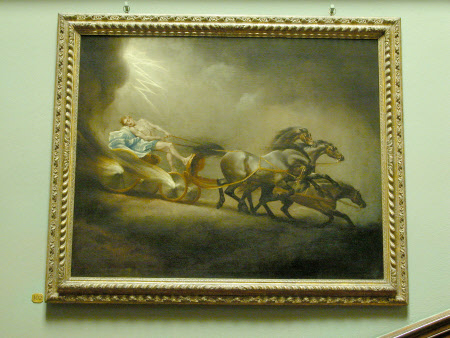The Fall of Phaeton
George Stubbs, RA (Liverpool 1724 – London 1806)
Category
Art / Oil paintings
Date
c. 1762 (original first exhibited) - 1781 (payment made to artist for a large purchase of pictures)
Materials
Oil on canvas
Measurements
965 x 1219 mm (39 x 48 in)
Place of origin
England
Order this imageCollection
Saltram, Devon
NT 872175
Summary
Oil painting on canvas, The Fall of Phaeton by George Stubbs, RA (Liverpool 1724 – London 1806), signed Stubbs pinxit [1777 was previously read with some uncertainty as to the last digit]. This inscription was apparently first read after the painting underwent restoration in the 1970s, but there is no trace of it now. Phaeton, the young son of Apollo (or Helios), begged his father to let him drive the chariot of the sun. He reluctantly conceded and gave his son the reins. Inexperienced, Phaeton quickly lost control of the horses and the sun-chariot veered out of control threatening to set Earth ablaze. To avoid total disaster Zeus killed the boy with a thunderbolt, hurling his flaming body into the River Eridanos. Stubbs first tackled the subject of Phaeton in a picture exhibited at the Society of Artists in 1762 (no. 109 'Phaeton') and again in a painting exhibited there in 1764 (no. 110 'Phaeton'). These presumably correspond - though there is no means of knowing which was which - to the two compositions known only from two mezzotints in reverse by Benjamin Green: the first, very close to the present picture but with a few differences, originally published by Ryland & Bryer, c.1765-6 (see British Museum, London, 1877,0609.1954; see also Christopher Lennox-Boyd et al., George Stubbs: The Complete Engraved Works, 1989, no.3; exh.cat. 2000, no.26); and the second, with four white horses published by Green himself on 18 March 1770 (see British Museum, London, 2010,7081.2229; see also Lennox-Boyd, no.8; exh.cat.2000, no.28). The former has four raggedly harnessed roans, the furthest of which is biting the neck of the horse next to it, and a terrified, blonde-haired Phaethon leaning right back in his desperate attempts to restrain them. The second has four greys in echelon, with the nearest one biting the neck of the horse next to it, and an anxious but more controlled Phaethon, with mid-coloured hair, leaning only slightly backward as he pulls on the reins. The present picture may be the one exhibited in 1762 and published c. 1765-66. However, payments made to Stubbs by the 1st Lord Boringdon in May 1778 (2 guineas) and February 1781 (1,050 guineas) may suggest that Stubbs painted another version and sold it, along with other pictures (although there is no record of Stubbs having painted any other pictures for Lord Boringdon, to which this payment might also refer), some time after painting the original with roans.
Provenance
Accepted with Saltram house and the more important chattels by HM Treasury in part payment of death-duties from the executors of Edmund Robert Parker, 4th Earl of Morley (1877-1951) and transferred to the National Trust in 1957
Credit line
Saltram, The Morley Collection (accepted in lieu of tax by HM Treasury, and transferred to The National Trust in 1957)
Makers and roles
George Stubbs, RA (Liverpool 1724 – London 1806), artist
Exhibition history
Stubbs and The Wild, Holburne Museum of Art, Bath, 2016, no.4
References
Hall 2000: Nicholas H. J. Hall (ed.), Fearful Symmetry: George Stubbs, Painter of the English Enlightenment, exh. cat., Hall & Knight Ltd., New York 2000, pp. 120-3, no. 25, pl. 25 Stubbs and the Wild (Ed. Amina Wright), The Holburne Museum, Bath, 25 June to 2 October 2016, p. 12, fig. 4

